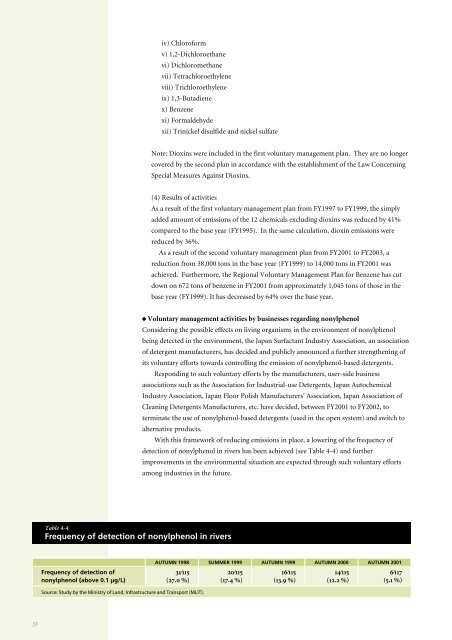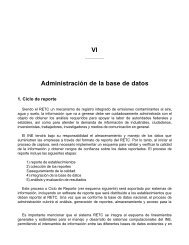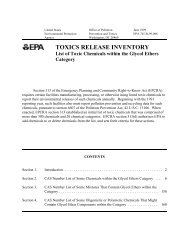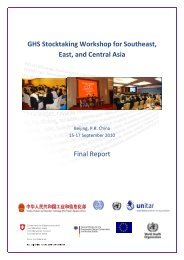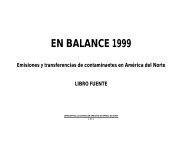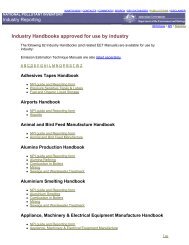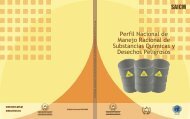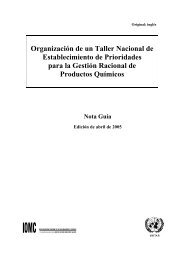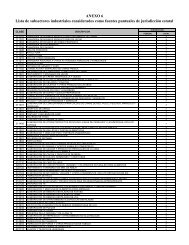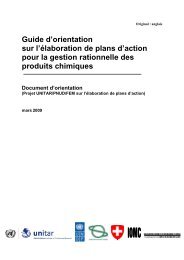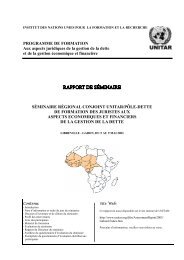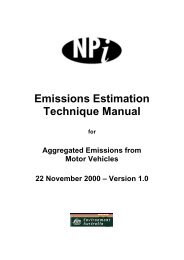NATIONAL PROFILE on Chemicals Management - UNITAR
NATIONAL PROFILE on Chemicals Management - UNITAR
NATIONAL PROFILE on Chemicals Management - UNITAR
- No tags were found...
You also want an ePaper? Increase the reach of your titles
YUMPU automatically turns print PDFs into web optimized ePapers that Google loves.
iv) Chloroformv) 1,2-Dichloroethanevi) Dichloromethanevii) Tetrachloroethyleneviii) Trichloroethyleneix) 1,3-Butadienex) Benzenexi) Formaldehydexii) Trinickel disulfide and nickel sulfateNote: Dioxins were included in the first voluntary management plan. They are no l<strong>on</strong>gercovered by the sec<strong>on</strong>d plan in accordance with the establishment of the Law C<strong>on</strong>cerningSpecial Measures Against Dioxins.(4) Results of activitiesAs a result of the first voluntary management plan from FY1997 to FY1999, the simplyadded amount of emissi<strong>on</strong>s of the 12 chemicals excluding dioxins was reduced by 41%compared to the base year (FY1995). In the same calculati<strong>on</strong>, dioxin emissi<strong>on</strong>s werereduced by 36%.As a result of the sec<strong>on</strong>d voluntary management plan from FY2001 to FY2003, areducti<strong>on</strong> from 38,000 t<strong>on</strong>s in the base year (FY1999) to 14,000 t<strong>on</strong>s in FY2001 wasachieved. Furthermore, the Regi<strong>on</strong>al Voluntary <strong>Management</strong> Plan for Benzene has cutdown <strong>on</strong> 672 t<strong>on</strong>s of benzene in FY2001 from approximately 1,045 t<strong>on</strong>s of those in thebase year (FY1999). It has decreased by 64% over the base year.● Voluntary management activities by businesses regarding n<strong>on</strong>ylphenolC<strong>on</strong>sidering the possible effects <strong>on</strong> living organisms in the envir<strong>on</strong>ment of n<strong>on</strong>ylphenolbeing detected in the envir<strong>on</strong>ment, the Japan Surfactant Industry Associati<strong>on</strong>, an associati<strong>on</strong>of detergent manufacturers, has decided and publicly announced a further strengthening ofits voluntary efforts towards c<strong>on</strong>trolling the emissi<strong>on</strong> of n<strong>on</strong>ylphenol-based detergents.Resp<strong>on</strong>ding to such voluntary efforts by the manufacturers, user-side businessassociati<strong>on</strong>s such as the Associati<strong>on</strong> for Industrial-use Detergents, Japan AutochemicalIndustry Associati<strong>on</strong>, Japan Floor Polish Manufacturers’ Associati<strong>on</strong>, Japan Associati<strong>on</strong> ofCleaning Detergents Manufacturers, etc. have decided, between FY2001 to FY2002, toterminate the use of n<strong>on</strong>ylphenol-based detergents (used in the open system) and switch toalternative products.With this framework of reducing emissi<strong>on</strong>s in place, a lowering of the frequency ofdetecti<strong>on</strong> of n<strong>on</strong>ylphenol in rivers has been achieved (see Table 4-4) and furtherimprovements in the envir<strong>on</strong>mental situati<strong>on</strong> are expected through such voluntary effortsam<strong>on</strong>g industries in the future.Table 4-4Frequency of detecti<strong>on</strong> of n<strong>on</strong>ylphenol in riversAUTUMN 1998 SUMMER 1999 AUTUMN 1999 AUTUMN 2000 AUTUMN 2001Frequency of detecti<strong>on</strong> of 31⁄115 20⁄115 16⁄115 14⁄115 6⁄117n<strong>on</strong>ylphenol (above 0.1 µg/L) (27.0 %) (17.4 %) (13.9 %) (12.2 %) (5.1 %)Source: Study by the Ministry of Land, Infrastructure and Transport (MLIT).33


